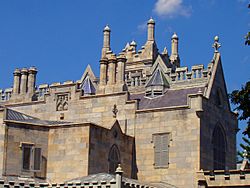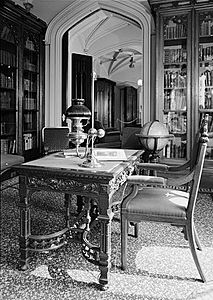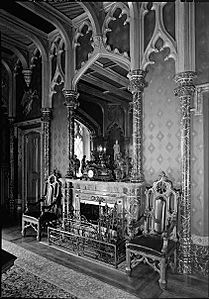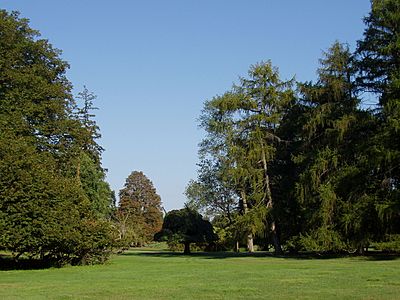Lyndhurst (mansion) facts for kids
|
Lyndhurst
(Jay Gould Estate) |
|

The front facade of Lyndhurst
|
|
| Location | Tarrytown, New York, U.S. |
|---|---|
| Nearest city | White Plains, New York, U.S. |
| Area | 67 acres (27 ha) |
| Built | 1838 |
| Architect | Alexander Jackson Davis |
| Architectural style | Gothic Revival |
| Website | www.lyndhurst.org |
| NRHP reference No. | 66000582 |
Quick facts for kids Significant dates |
|
| Added to NRHP | November 13, 1966 |
| Designated NHL | November 13, 1966 |
Lyndhurst, also known as the Jay Gould estate, is a Gothic Revival country house that sits in its own 67-acre (27 ha) park beside the Hudson River in Tarrytown, New York, about a half mile south of the Tappan Zee Bridge on US 9. The house was designated a National Historic Landmark in 1966.
Contents
History
The home was designed in 1838 by Alexander Jackson Davis, and owned in succession by New York City mayor William Paulding Jr., merchant George Merritt, and railroad tycoon Jay Gould.
Paulding named his house "Knoll", although critics quickly dubbed it "Paulding's Folly" because of its unusual design that includes fanciful turrets and asymmetrical outline. Its limestone exterior was quarried at Sing Sing in present-day Ossining, New York.
Merritt, the house's second owner, engaged Davis as his architect, and in 1864–1865 doubled the size of the house, renaming it "Lyndenhurst" after the estate's linden trees. Davis' new north wing included an imposing four-story tower, a new porte-cochere (the old one was reworked as a glass-walled vestibule), a new dining room, two bedrooms and servants' quarters.
Gould purchased the property in 1880 to use as a country house, shortened its name to "Lyndhurst" and sometimes spelled it "Lindhurst; he occupied it until his death in 1892. In 1961, Gould's daughter Anna Gould donated it to the National Trust for Historic Preservation. The house is now open to the public.
Architecture
Lyndhurst's rooms are strongly Gothic in character. Hallways are narrow, windows small and sharply arched, and ceilings are fantastically peaked, vaulted, and ornamented. The effect is at once gloomy, somber, and highly romantic; the large, double-height art gallery provides a contrast of light and space.
The house sits within a landscape park, designed in the English naturalistic style by Ferdinand Mangold, whom Merritt hired. Mangold drained the surrounding swamps, created lawns, planted specimen trees, and built a conservatory. The park is an outstanding example of 19th-century landscape design with a curving entrance drive that reveals "surprise" views of rolling lawns accented with shrubs and specimen trees. The 390-foot-long (120 m) onion-domed, iron-framed, glass conservatory was one of the largest privately owned greenhouses in the United States when constructed.
Gallery
See also
 In Spanish: Lyndhurst (mansión) para niños
In Spanish: Lyndhurst (mansión) para niños









